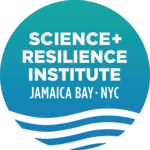Generous gifts from the Bernard and Anne Spitzer Trust and others support resilience planning that gives residents and community leaders a more central role.

The Science and Resilience Institute at Jamaica Bay has launched new resilience initiatives to link community and environmental resilience around Jamaica Bay, with the help of generous gifts from the Bernard and Anne Spitzer Trust, among others. Since its founding in 2013, the Science and Resilience Institute has raised over $2.7 million to support City of New York resilience efforts, with a majority of that funding (over 70%) going toward new research and capacity building efforts. Over the next year, the Science and Resilience Institute and partners will work with communities in south Brooklyn and Queens to use science and local knowledge to forge pathways toward resilience.
“With generous support from the Bernard and Anne Spitzer Trust, we are greatly advancing a number of resilience initiatives to support the City of New York, the National Park Service, and Jamaica Bay residents,” said Adam Parris, Executive Director of the Institute. “Communities around Jamaica Bay have creative ideas about improving resilience that, in many cases, are not divergent from existing city, state, and federal plans. We can help bridge that gap by convening people and by building a shared understanding of risks and opportunities, particularly as it relates to using nature to combat climate change.”
Projections for flooding suggest that, by the 2080s, the number of residences in floodplain defined by the National Flood Insurance Program will increase by almost 8,000. Residents living close to the Bay are encountering areas may incur higher costs associated with floodproofing and flood insurance.
“Robust community engagement undergirds all of New York City’s resiliency planning,” said Jainey Bavishi, Director of the Mayor’s Office of Recovery and Resiliency. “The Science and Resilience Institute, Brooklyn College, and their academic and non-governmental partners have assembled a team with proven experience in resiliency research to build a strong foundation of equitable engagement and shared knowledge in Jamaica Bay.”
Along with Brooklyn College’s Center for the Study of Brooklyn and Public Agenda, the Science and Resilience Institute will establish meaningful processes for residents in Jamaica Bay to participate in regional resilience efforts. The goal is to develop an annual cycle of resilience planning that includes deliberation, idea generation, games, and community building. By placing residents in more central roles, this process will allow them to help prioritize issues, deliberate with relevant agencies, and shape research and action that support resilience and adaptation in Jamaica Bay.

“This project builds upon the many years of work in Jamaica Bay by taking advantage of new engagement strategies while respecting the knowledge and work already happening in the communities,” said Nicole Cabral, Associate Director of Public Engagement at Public Agenda.

Throughout the engagement process, the Wildlife Conservation Society and the Stevens Institute of Technology will use tools to perform interactive analysis of ways to use nature to contribute to social and environmental benefits. The tools help examine how different actions result in more or less of a reduction in stormwater, an objective of the city and communities, while also contributing to habitat for species.
“New Yorkers should work with the city and experts to figure out how to withstand the next Hurricane Sandy,” said Eric Sanderson of the Wildlife Conservation Society. “They can contribute their ideas. Visionmaker.nyc is one way to do that, using a knowledge of the historical ecology of the city, an assessment of the current state, and an opportunity to develop and share their own visions for their own neighborhoods into the future. We all have the responsibility and the honor to imagine the future of New York.”
Jamaica Bay is New York City’s door to the Atlantic Ocean and a part of Gateway National Recreation Area. The Bay contains more than 10,000 acres of city and federal parkland. Its natural areas are habitat for numerous wildlife species, while its beaches, trails and open fields provide recreation opportunities for the area’s surrounding population. Jamaica Bay is also critical to the future of New York City and its ability to address the threats of global climate change and the impact of extreme weather events like Hurricane Sandy.
“Jamaica Bay is an outstanding resource,” said Joshua Laird, Commissioner of the National Parks of New York Harbor, “and we look forward to collaborating with the Institute on studies focusing on wetlands, water quality, shoreline protection, and ecosystem monitoring there. Along with partners such as the Jamaica Bay & Rockaway Parks Conservancy, these research efforts will help support the design and implementation of restoration practices and other strategies that will enhance the resilience and long-term sustainability of the bay.”


Even as New York City and local groups plan for the future, residents around Jamaica Bay require technical assistance to prepare for regular flooding from extreme high tides and ongoing weather and climate hazards. The Science and Resilience Institute, New York Sea Grant (NYSG), and Cornell Cooperative Extension will team with the Mayor’s Office of Resiliency and Recovery, New York City Emergency Management, the Consortium for Climate Risk in the Urban Northeast, and local residents to track flooding and keep people safe during an emergency. Citizens will collect and relay observations of flooding to the New York City Panel on Climate Change, and the Science and Resilience Institute and its partners will help bring experts and community-based organizations to different neighborhoods to increase literacy and highlight preparedness tools.
“Living in coastal cities presents unique hazards from water—from storm surge to extreme storms to storm water, ” said Katherine Bunting-Howarth, the Director of New York Sea Grant. “NYSG is pleased to partner on this project to help empower those who work, live and play in the Jamaica Bay watershed to report on and be prepared for flooding.”
And, the Science and Resilience Institute will ensure that younger residents of Jamaica Bay will be educated on these issues aboard the CUNY I—a cutting-edge research vessel based at Kingsborough Community College, CUNY. Funded through Governor Cuomo’s CUNY 2020 initiative, CUNY I is a 63-foot catamaran powered by a hybrid electric and diesel propulsion system, using only one-third of the fuel of a normal diesel-powered engine. This technology saves fuel and emissions, helping to meet greenhouse gas reduction targets. The vessel is also ‘zero discharge’ compliant, meaning that it does not produce any cooling or grey/black water discharge or hydraulic leakage that can be detrimental to marine ecosystems.







